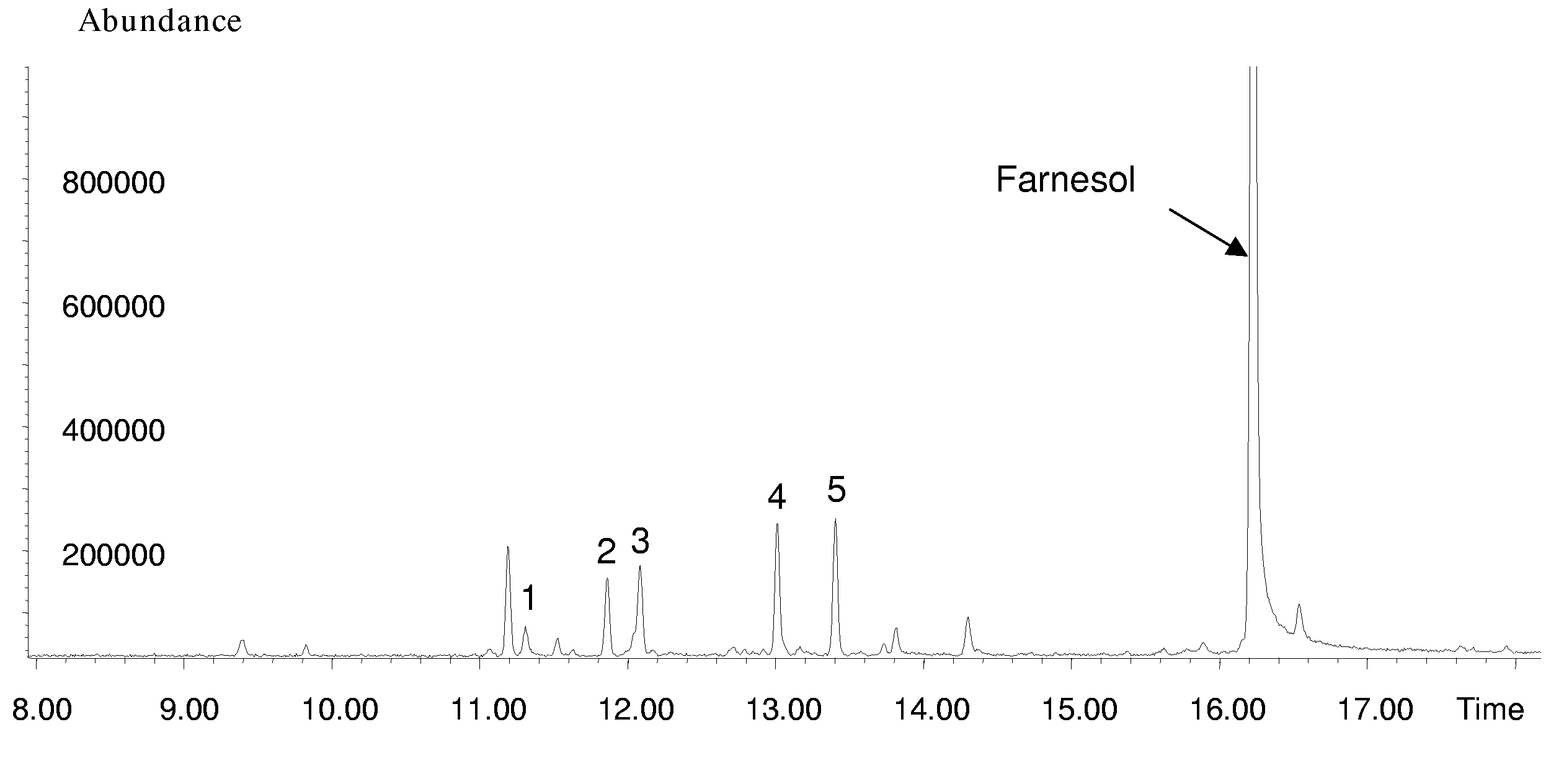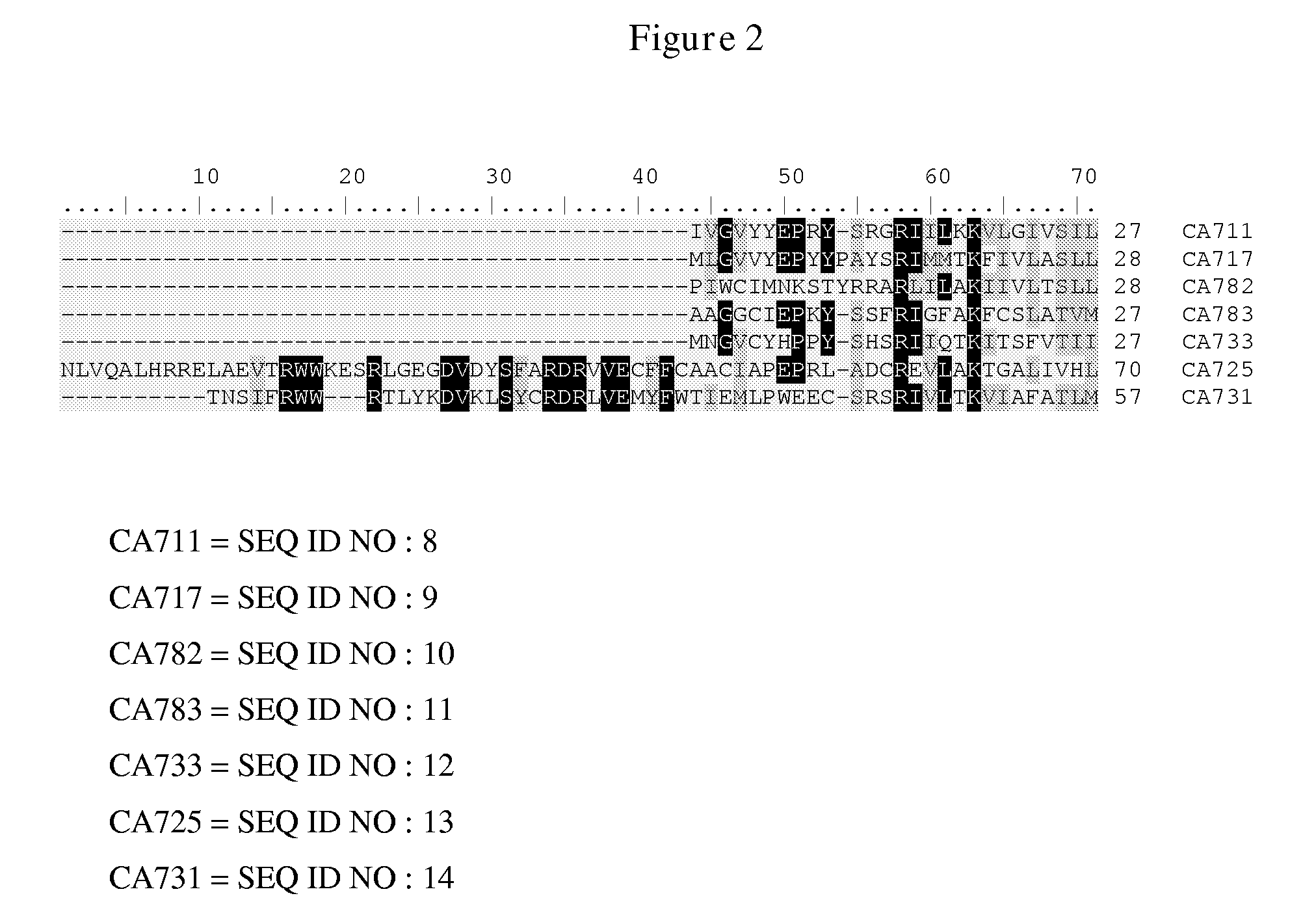Novel Sesquiterpene Synthases and Methods of their Use
a technology of sesquiterpene and synthase, which is applied in the field of new terpene synthases, can solve the problems of decreasing the availability of commercially available natural extracts, affecting the quality of natural extracts,
- Summary
- Abstract
- Description
- Claims
- Application Information
AI Technical Summary
Problems solved by technology
Method used
Image
Examples
example 1
Vetiver roots material, isolation of mRNA and cDNA synthesis
[0149]Vetiveria zizanoides (Vetiver) plants were obtained from a plant nurseries (‘La Compagnie des Plantes Australes’, Les Avirons, The Réunion Island, France). The plants were cultivated in pots in a green house at the Lullier Agronomy research Station (Switzerland) and were propagated vegetatively by dividing six months to one-year-old clumps. In the greenhouse conditions, transplanted vetiver cuttings start sprouting after one to three weeks and the roots volume is generally tripled or quadrupled after one-year cultivation.
[0150]For harvesting of the roots, the plants were dug out from the pots and rinsed with tap water. The sesquiterpene content of the roots was evaluated as follows: the roots were cut in small pieces or crushed in liquid nitrogen using a mortar and pestle and extracted with diethyl ether or pentane; after concentration, the extracts were analyzed by GC and GC-MS. Plants obtained after transplantation ...
example 2
Isolation of Fragments of cDNA Encoding for Sesquiterpene Synthases from Vetiver Roots
[0153]Fragments of cDNA encoding for sesquiterpene synthases were amplified using degenerated primers specific for plant sesquiterpene synthases nucleotidic sequences.
[0154]Sesquiterpene-synthase-specific oligonucleotides have been previously designed from an alignment of plant sesquiterpene synthases amino-acid sequences (WO 04 / 031376). Six primers (four forward and two reverse) were designed from three regions conserved among the plant sesquiterpene synthases amino-acid sequences. They were named TpsVF1, TpsVF2, TpsCF1, TpsCF2, TpsVR3 and TpsCR3 (WO 04 / 031376). In addition, a set of oligonucleotides was designed for improved specificity towards sesquiterpene synthases nucleotidic sequences of vetiver. Sequence comparison of terpene synthases isolated from different plants has shown high sequence homologies in relation to phylogeny. The sequence homology is high among terpene synthases from taxono...
example 3
Amplification of Full-Length cDNA Encoding for Sesquiterpene Synthases by Rapid Amplification of cDNA Ends (RACE)
[0160]Forward specific primers were designed from these new cDNA fragments (Table 2). 3′RACE was performed as follows. First, a reverse transcription was performed at 60° C. using the oligo(dT)20 primer, 1.5 microg of total RNA and the Thermoscrip™ reverse transcriptase, in the same condition as described above for the RT-PCR. A first PCR was performed using the dTadaptor primer and a forward cDNA-specific primer. The PCR mixture contained 0.4 μM cDNA-specific primer, 0.4 μM of dTadaptor primer (Table 2), 300 μM each dNTPs, 5 μL of 10× HotStartTaq® DNA polymerase buffer (Qiagen), 2 μL of the cDNA, 0.5 μL of HotStartTaq® DNA polymerase in a final volume of 50 μL. The cycling conditions were: 15 min at 95° C.; 35 cycles of 45 sec at 94° C., 45 sec at 48° C. and 2 min 30 sec at 72° C.; and 10 min at 72° C. A nested PCR was performed using a PCR mixture with the same composit...
PUM
| Property | Measurement | Unit |
|---|---|---|
| pH | aaaaa | aaaaa |
| wt. % | aaaaa | aaaaa |
| size distribution | aaaaa | aaaaa |
Abstract
Description
Claims
Application Information
 Login to View More
Login to View More - R&D
- Intellectual Property
- Life Sciences
- Materials
- Tech Scout
- Unparalleled Data Quality
- Higher Quality Content
- 60% Fewer Hallucinations
Browse by: Latest US Patents, China's latest patents, Technical Efficacy Thesaurus, Application Domain, Technology Topic, Popular Technical Reports.
© 2025 PatSnap. All rights reserved.Legal|Privacy policy|Modern Slavery Act Transparency Statement|Sitemap|About US| Contact US: help@patsnap.com



